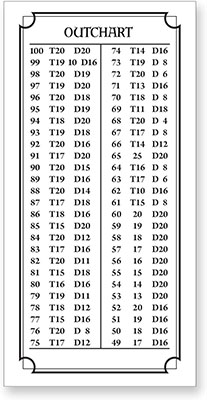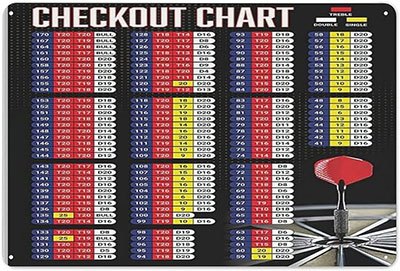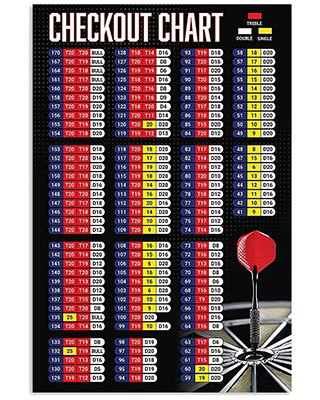Do you want to learn how to impress your friends over a game of darts? Well, I think it's time for you to learn to use one of the essential tools for successful scores-a dart chart.
Dart out chart is also known as a ‘checkout table’ that can help you end the game successfully and with the highest score. A chart is going to be your best companion, but there are a few ground rules.
Many players tend to overlook the chart since it can be a little complicated to comprehend it. No need for despair, we are here to break it down and make the matter as simple as it gets.
More...
What is Even a Dart Out Chart?

Dart out chart is one of the most helpful tools to have by your side in x01 dart games (301, 701, etc.).
Why would you care about them? Well, for starters, they contain all the number combinations for double out scoring. Everything you need to know about doubling out in a darts game is in this little helper.
There is no need to let a simple thing like a dart out chart stop you from creating your perfect score. We will teach you how to wisely use the combinations to your advantage and crack the code to successful throws.
If you are a beginner at darts, we advise you to practice consistency and precision before attempting to tackle dart out charts. Once you overcome this, you are ready to take on the world of tables and calculate your way to success.
You can take a look at this video and take some notes on other techniques.
Let’s Get Down to Business
We will be covering several essential features of a dart out a chart in this article and how to multiply the values to keep track of your scores.
For starters, let’s focus on the different sections of the chart and how they work.
1. 40 to 2 Chart: Madhouse To Tops
Firstly, let’s start with the dart out chart that has outs from 40 to 2. This is one of the more straightforward charts to comprehend. This is our favorite when it comes to beginner’s practice. It allows you to aim for consistency when you hit the simple outs.
For each score in the chart, there is an outshot that is easier than others. However, you always have options when it comes to this. You do not need to rely on somebody else’s performance and scores. It is still better to figure out what works for you and what doesn’t. With the process of elimination, you are one step closer to success.
For example, if you are left with 17, you would hit S1 and D8. However, you can notice that you can as well hit S13 and finish with D2. The ultimate choice up to you once you figure out how the chart works.
2. 60 to 41 Chart

Once you have covered the 40 to 2 chart, you are ready for your next challenge. That is the 60 to 41 shot. The deal here is to know your advantages and disadvantages, that is, knowing what to avoid.
The previous example is based on hitting a single dart finish. In this chart, shots require a double dart finish.
Can you feel the heat rising?
Because we can. This is one of the challenging tables to tackle, so pay close attention.
When you aim for 60, it requires you to hit S20 or D20 as a finishing point. As you can notice, D20 is out for 40. This is why we recommend you first begin with the easier chart and then slowly work your way up.
When you are trying to hit 46, the ideal aims are S6 or S10, but you can hit S6 and finish with D20. From this and many other examples, it is noticeable that playing darts revolves around finding your way around obstacles and creating your perfect shot.
3. 110 To 61 Chart
Now it's time to cover the well-known quick finishes - 110 to 61.
With this one, you can quickly finish a 101 game in just one turn. One fascinating thing about this chart is that it can give you multiple finishes for each of the numbers on the board.
That being said, this chart gives you the most room to figure out what works for you and what doesn’t.
4. 170 To 111 Chart

Lastly, the final stage is called Show-Outs. They are considered the toughest ones for consistent throws. But, if you master them, you are ready for your x01 game tournament.
We have to mention again that you should jump from one chart to another, assuming that you have figured it out when in reality, you are still confused. It all plays out in the end; you just need a bit of practice and will improve your skills daily.
Once you accomplished all charts, congrats! Nothing is stopping you now.
5. How Should You Track Your Progress?
When you are first acquainted with the charts, you can begin to keep tabs on the process. All you should do is calculate your averages. To do this, divide the score at the end game by the number of the darts you have thrown.
This should indicate how your progress is doing and what you need to improve.
You can also take a look at the scoring zone guide and study it daily. It’s all about efficient calculations.
Conclusion
If you were someone who thought that darts is all about lucky shots, we bet your outlook on darts has changed after this article. There is a lot of science behind darts and charts, but it is nothing to stress over.
All you need is undivided attention and commitment to make yourself the best dart player there is. Ultimately, to do so, you must learn all about dart out charts.
Think about it; even the best ones had to cover the theoretical part to earn the title they deserved.
